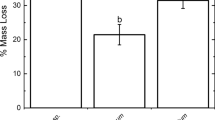Summary
Four plots of alpine meadow communities (mats) of the Northern Calcareous Alps are compared with regard to dry substance (DS), N-, P-, and K-content of living and dead overground and total underground phytomass. The Caricetum firmae F (altitude 2,010 m) produces the least green mass but accumulates the highest amount of dead substance (litter). In all parts it has the lowest content of N, P, K. The opposite is the Caricetum ferrugineae C (1,900 m): Small dead mass, but high production of green mass and high content of N and K in the living overground and total underground phytomass. The Nardetum N (1,930 m) is marked by relatively high amounts of P in living and dead parts. The Seslerio-Semperviretum S (2,150 m) is intermediate but with rather low contents of K.
In each plot the average total nitrogen found in the underground phytomass is about 200% of the amount found in the living overground phytomass. This suggests a similar relation of living mass in the two components of the total phytomass.
The fluctuations in the phytomass throughout the growing season are represented for S. The green mass increase is about 200g DS with about 3 g N/m2. This amount corresponds to the average mineralization supply of N during the growing season as obtained by the field incubation method (3.3 g/m2, in 0–15 cm depth of the soil). In C the average mineralization is lower whereas the green mass production amounts to 300 g DS/m2 with 5.5 g N/m2. This discrepancy supports again our hypothesis of an “internal nitrogen cycle” in the Carex ferruginea community. In F and N we find a lower incorporation of N into the annual green mass production compared with the N mineralized in the upper soil layers (Table 1).
Lactate-soluble P and K were as a rule not accumulated in our soil incubation tests. The actual values and their amplitude during the growing season scarcely coincide with the differences of P and K in the green mass.
Similar content being viewed by others
References
Braun-Blanquet, J.: Pflanzensoziologie. Berlin: Springer 1928
Ellenberg, H., Mueller-Dombois, D.: Tentative physiognomic-ecological classification of plant formations of the earth. Ber. Geobot. Inst. ETH Zürich 37, 21–55 (1967)
Gerlach, A.: Methodische Untersuchungen zur Bestimmung der Stickstoffnettomineralisation. Scripta Geobotanica, Bd. 5. Göttingen: Goltze 1973
John, M. K.: Colorimetric determination of phosphorus in soil and plant materials with ascorbic acid. Soil Sci 109, 214–220 (1970)
Kubiena, W. L.: Bestimmungsbuch und Systematik der Böden Europas. Stuttgart: Enke 1953
Labroue, L., Lascombes, G.: Minéralisation de l'azote organique dans les sols alpins du Pic du Midi de Bigorre. Oecol. Plant. 6, 247–270 (1971)
León, R.: Balance d'eau et d'azote dans les prairies à litière des alentours de Zurich. Veröff. Geobot. Inst. ETH Zürich 41, 2–67 (1968)
Möller, G.: Zur Bestimmung des Gesamtphosphors im Boden nach verschiedenen Methoden. Z. Pflanzenern. u. Bodenk. 118, 44–52 (1967)
Oberdorfer, E.: Pflanzensoziologische Exkursionsflora für Süddeutschland. Stuttgart: Ulmer 1970
Rehder, H.: Zur Ökologie, insbesondere Stickstoffversorgung subalpiner und alpiner Pflanzengesellschaften im Naturschutzgebiet Schachen (Wettersteingebirge). Diss. Bot., Bd. 6. Lehre: Cramer 1970
Rehder, H.: Zum Stickstoffhaushalt alpiner Rasengesellschaften. Ber. dtsch. bot. Ges. 84, 759–767 (1971)
Rodin, L. E., Bazilevich, N. I.: Dynamics of the organic matter and biological turnover of ash elements and nitrogen in the main types of the world vegetation [Russian]. Acad. of Sci., Leningrad (1965)
Runge, M.: Investigations of the content and the production of mineral nitrogen in soils. In: Integrated experimental ecology, Ecological studies (ed. H. Ellenberg), vol. 2, p. 191–202. Berlin-Heidelberg-New York: Springer 1971
Schmidt, W.: Untersuchungen über die Phosphorversorgung niedersächsischer Buchenwaldgesellschaften. Scripta Geobotanica, Bd. 1. Göttingen:Goltze 1970
Schüller, H.: Die CAL-Methode, eine neue Methode zur Bestimmung des pflanzenverfügbaren Phosphates in Böden. Z. Pflanzenern. u. Bodenk. 123, 48–63 (1969)
Author information
Authors and Affiliations
Rights and permissions
About this article
Cite this article
Rehder, H. Nutrient turnover studies in alpine ecosystems. Oecologia 22, 411–423 (1976). https://doi.org/10.1007/BF00345317
Received:
Issue Date:
DOI: https://doi.org/10.1007/BF00345317




